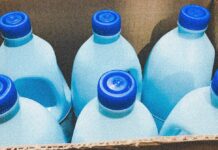Victoria records 484 new infections, more than Australia’s previous national high, as the state premier says nine in 10 symptomatic residents aren’t isolating correctly.
In the peak of the first wave, on 28 March, the Australia-wide total was 469 cases reported in a single day.
Two Victorian men in their 90s also passed away overnight taking the state’s death toll to 44. Both men were residents in aged care homes.
Of Wednesday’s cases, 97 are connected to known outbreaks and 387 are under investigation. Victorian premier Daniel Andrews suggested that the total may be reduced overnight as duplicates are removed.
Andrews said he would not be announcing changes to restrictions or the implementation of a “stage four” lockdown on Wednesday.
He said that people failing to isolate between the onset of symptoms and getting tested may be a large source of new infections.
“From 3,810 cases, which are the cases between July 7 and July 21, I’m very unhappy and very sad to have to report that nearly 9 in 10 – or 3,400 cases – did not isolate between when they first felt sick and when they went to get a test,” he said.
“That means people have felt unwell and just gone about their business. They have gone out shopping. They have gone to work. They have been at the height of their infectivity. And they have just continued on as usual.”
Andrews said Victorians were also failing to isolate while waiting results.
“I’m equally saddened to have to report that 53% – or 2,056 of those 3,810 cases – did not isolate, that is, did not stay at home and have no contact with anybody else between when they had their test taken and when they got the results of that test.”
Andrews said unless these behaviours change numbers will continue to rise and the lockdown imposed of Melbourne and Mitchell shire will be extended.
Andrews suggested that those in insecure or casual work were more likely to work while sick or awaiting test results.
“There is a large proportion of these people who are making these choices because, in their judgement, they’ll look at their bank balance, they’ll look at the fact that, if they don’t work the shift, they won’t get paid for the shift, they don’t have sick leave – this is a commentary on insecure work,” he said.
“It’s a very important debate to have, we can have that debate another time. In the meantime, though, trying to hone in on the problem, understand the problem, and then put in place specific measures to deal with it.”
Andrews highlighted the $1,500 dollar hardship payment available to those required to isolate and do not have access to sick leave, but this is only accessible if an individual has tested positive or are close contacts who have been asked to isolate.
Those awaiting test results are not eligible.
“If there’s a need for us to go further and deal with that one and two-day period, which is where those 53% of people who are not staying home … we’re just doing further work on that.”
When asked if there were specific penalties for those who leave the home for essential reasons while awaiting test results, Andrews said he was unsure.
“I’m not entirely sure of that … Let me come back to you in terms of whether there’s a specific penalty that can be applied. We’ll get much better outcomes by appealing to people and dealing with the drivers of this rather than fining people for it,” he said.
Chief health officer Brett Sutton defended the state’s contact tracing operations, after multiple reports of close contacts waiting multiple days to be contacted by the department of health and told to isolate.
“We would absolutely aim, from the time we’ve got a receipt of a positive result, to phone people in the first 24 hours,” Sutton said.
He suggested up to a third of Victorians were not answering their phones went he department called.
“No one would be happy with a delay in terms of identifying close contacts. So, again, if people can pick up the phone, we know that we’ll get those details earlier and we can follow up with those close contacts. If people already know that they are a case, they can go through the process of detailing all of those close contacts. And indeed, contacting them if they’re comfortable and comfort in doing so.”
NSW also reported 16 cases overnight, one from hotel quarantine.
Premier Gladys Berejiklian said it was reassuring the remaining 15 cases were from known sources.
“The one positive take from all of those cases … they were from existing known clusters or existing known contacts. So the fact that there is not a new stream of outbreak is reassuring at one level.”
NSW chief health officer, Dr Kerry Chant, said that of the new cases 11 were associated with the Thai Rock Restaurant, bring the cluster up to 37. This included a man from the Hunter New England region.
“They were a close contact of someone who has been to the Thai Rock. I think this just highlights how rapidly the virus can move,” she said.
“For a period of time we were concerned that the case in Hunter New England could have been another cluster that we didn’t know, a tip of the iceberg, but the fact that we were then able to link it back to someone who attended the Thai Rock and that link was established means we are dealing with a different issue.”
Chant confirmed the man was still infectious for a period of time while in the region and further contact tracing was underway.
Residents from the Hunter New England region have been advised by local health authorities not to travel to Sydney if possible.
Although the state government has not posed formal restrictions in regards to regional travel, Chant suggested that all residents “just reflect on their [non-essential] travel arrangements” in the coming weeks.
Three of Wednesday’s cases were associated with the Crossroads Hotel Cluster, bringing the total to 53.
The last person was a close contact of a previous case and is not associated with any clusters.
Chant said there were multiple points of infection from Victoria into NSW.
“Genomic screening of the virus has helped us to understand that they are all a strain similar to that circulating in Victoria. Now, that is important to note that we don’t think they are all from the one person. What they represent is that the virus is similar and we believe that there were different sources of exposure.”
Berejiklian defended the hardening of the NSW/Victoria border, a move which limited the reasons border town residents can cross the state lines.
“When we closed the border initially there was still in excess of 200,000 permits given, and unfortunately, as you see with the situation in Victoria, we don’t have any assurance that there is no community transmission in regional Victoria. Now, that puts all of New South Wales at risk,” she said.
“It would have been far easier for us to do what Queensland did to us. We could have easily said, that is a border and that is it.”
Queensland also reported one new case in the past 24 hours.
Premier Annastacia Palaszczuk said this was a member of the Australian Defence Force returning from overseas and was quarantining.
The state now has three active cases.








